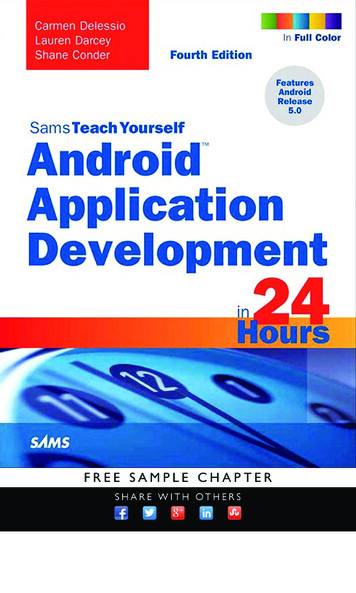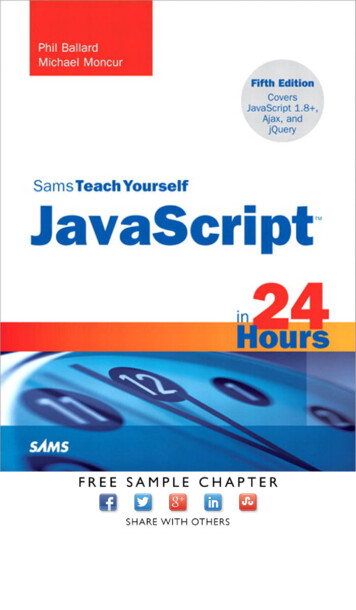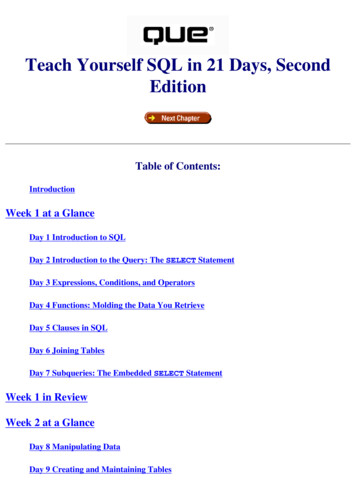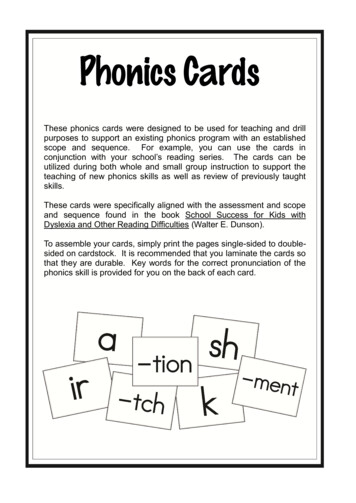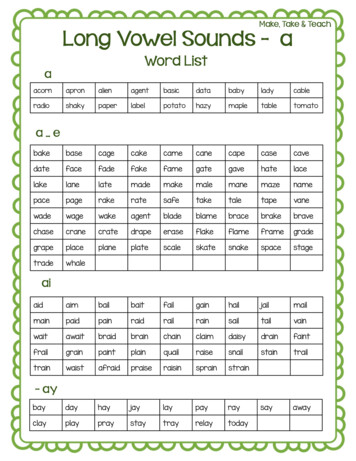
Transcription
How to teach GrammarWhat is Grammar?Why should we teach Grammar?23APPROACHESThe deductive approach – rule-driven learningThe inductive approach – the rule-discovery pathThe functional- notional approachTeaching grammar in situational contextsTeaching grammar through textsTeaching grammar through storiesTeaching grammar through songs and rhymesSome rules for teaching grammar6101521252728311
What is Grammar? Language user’s subconscious internal systemLinguists’ attempt to codify or describe that system Sounds of language Structure and form of words Arrangement of words into larger units Meanings of language Functions of language & its use in context PhonologyMorphologySyntaxSemanticsPragmatics “Grammar is the business of taking a language to pieces, to see how it works.”(David Crystal) Grammar is the system of a language. People sometimes describe grammar as the"rules" of a language; but in fact no language has rules. If we use the word "rules", wesuggest that somebody created the rules first and then spoke the language, like a newgame. But languages did not start like that. Languages started by people makingsounds which evolved into words, phrases and sentences. No commonly-spokenlanguage is fixed. All languages change over time. What we call "grammar" is simplya reflection of a language at a particular time. Grammar is the mental system of rules and categories that allows humans to form andinterpret the words and sentences of their language. grammar adds meanings that are not easily inferable from the immediate context.The kinds of meanings realised by grammar are principally: representational - that is, grammar enables us to use language to describe theworld in terms of how, when and where things happene.g. The sun set at 7.30. The children are playing in the garden. interpersonal - that is, grammar facilitates the way we interact with otherpeople when, for example, we need to get things done using language.e.g. There is a difference between:Tickets!Tickets, please.Can you show me your tickets?May see your tickets?Would you mind if I had a look at your tickets.Grammar is used to fine-tune the meanings we wish to express.2
3
Why should we teach grammar?There are many arguments for putting grammar in the foreground in second languageteaching. Here are seven of them:1) The sentence-machine argumentPart of the process of language learning must be what is sometimes called item-learning —that is the memorisation of individual items such as words and phrases. However, there is alimit to the number of items a person can both retain and retrieve. Even travellers' phrasebooks have limited usefulness — good for a three-week holiday, but there comes a pointwhere we need to learn some patterns or rules to enable us to generate new sentences. That isto say, grammar. Grammar, after all, is a description of the regularities in a language, andknowledge of these regularities provides the learner with the means to generate a potentiallyenormous number of original sentences. The number of possible new sentences is constrainedonly by the vocabulary at the learner's command and his or her creativity. Grammar is a kindof 'sentence-making machine'. It follows that the teaching of grammar offers the learner themeans for potentially limitless linguistic creativity.2) The fine-tuning argumentThe purpose of grammar seems to be to allow for greater subtlety of meaning than a merelylexical system can cater for. While it is possible to get a lot of communicative mileage out ofsimply stringing words and phrases together, there comes a point where 'Me Tarzan, youJane'-type language fails to deliver, both in terms of intelligibility and in terms of appropriacy.This is particularly the case for written language, which generally needs to be more explicitthan spoken language. For example, the following errors are likely to confuse the reader:Last Monday night I was boring in my house.After speaking a lot time with him I thought that him attracted me.We took a wrong plane and when I saw it was very later because the plane took up.Five years ago I would want to go to India but in that time anybody of my friends didn't wantto go.The teaching of grammar, it is argued, serves as a corrective against the kind of ambiguityrepresented in these examples.3) The fossilisation argumentIt is possible for highly motivated learners with a particular aptitude for languages to achieveamazing levels of proficiency without any formal study. But more often 'pick it up as you goalong' learners reach a language plateau beyond which it is very difficult to progress. To put ittechnically, their linguistic competence fossilises. Research suggests that learners who receiveno instruction seem to be at risk of fossilising sooner than those who do receive instruction.4) The advance-organiser argumentGrammar instruction might also have a delayed effect. The researcher Richard Schmidt kept adiary of his experience learning Portuguese in Brazil. Initially he had enrolled in formallanguage classes where there was a heavy emphasis on grammar. When he subsequently leftthese classes to travel in Brazil his Portuguese made good progress, a fact he attributed to theuse he was making of it. However, as he interacted naturally with Brazilians he was awarethat certain features of the talk — certain grammatical items — seemed to catch his attention.He noticed them. It so happened that these items were also items he had studied in hisclasses. What's more, being more noticeable, these items seemed to stick. Schmidt concludedthat noticing is a prerequisite for acquisition. The grammar teaching he had receivedpreviously, while insufficient in itself to turn him into a fluent Portuguese speaker, had4
primed him to notice what might otherwise have gone unnoticed, and hence had indirectlyinfluenced his learning. It had acted as a kind of advance organiser for his later acquisitionof the language.5) The discrete item argumentLanguage seen from 'outside', can seem to be a gigantic, shapeless mass, presenting aninsuperable challenge for the learner. Because grammar consists of an apparently finite set ofrules, it can help to reduce the apparent enormity of the language learning task for bothteachers and students. By tidying language up and organising it into neat categories(sometimes called discrete items), grammarians make language digestible.(A discrete item is any unit of the grammar system that is sufficiently narrowly defined toform the focus of a lesson or an exercise: e.g. the present continuous, the definite article,possessive pronouns).6) The rule-of-law argumentIt follows from the discrete-item argument that, since grammar is a system of learnable rules,it lends itself to a view of teaching and learning known as transmission. A transmission viewsees the role of education as the transfer of a body of knowledge (typically in the form of factsand rules) from those that have the knowledge to those that do not. Such a view is typicallyassociated with the kind of institutionalised learning where rules, order, and discipline arehighly valued. The need for rules, order and discipline is particularly acute in large classes ofunruly and unmotivated teenagers - a situation that many teachers of English are confrontedwith daily. In this sort of situation grammar offers the teacher a structured system that can betaught and tested in methodical steps.7) The learner expectations argumentRegardless of the theoretical and ideological arguments for or against grammar teaching,many learners come to language classes with fairly fixed expectations as to what they will dothere. These expectations may derive from previous classroom experience of languagelearning. They may also derive from experience of classrooms in general where (traditionally,at least) teaching is of the transmission kind mentioned above. On the other hand, theirexpectations that teaching will be grammar-focused may stem from frustration experienced attrying to pick up a second language in a non-classroom setting, such as through self-study, orthrough immersion in the target language culture. Such students may have enrolled inlanguage classes specifically to ensure that the learning experience is made more efficient andsystematic. The teacher who ignores this expectation by encouraging learners simply toexperience language is likely to frustrate and alienate them.5
6
PRESENTING GRAMMARAPPROACHESThe deductive approach – rule driven learningA deductive approach starts with the presentation of a rule and is followed by examples inwhich the rule is applied.The grammar rule is presented and the learner engages with it through the study andmanipulation of examples.Advantages of a deductive approach: It gets straight to the point, and can therefore be time-saving. Many rules — especiallyrules of form — can be more simply and quickly explained than elicited fromexamples. This will allow more time for practice and application. It respects the intelligence and maturity of many - especially adult -students, andacknowledges the role of cognitive processes in language acquisition. It confirms many students' expectations about classroom learning, particularly forthose learners who have an analytical learning style. It allows the teacher to deal with language points as they come up, rather than havingto anticipate them and prepare for them in advance.Disadvantages of a deductive approach: Starting the lesson with a grammar presentation may be off-putting for some students,especially younger ones. They may not have sufficient metalanguage (i.e. languageused to talk about language such as grammar terminology). Or they may not be able tounderstand the concepts involved.Grammar explanation encourages a teacher-fronted, transmission-style classroom;teacher explanation is often at the expense of student involvement and interaction.Explanation is seldom as memorable as other forms of presentation, such asdemonstration.Such an approach encourages the belief that learning a language is simply a case ofknowing the rules.What is a rule ?In the Longman Activity Dictionary “rule” is defined as: a principle or order which guides behaviour, says how things are to be done etc,(prescriptive rule) the usual way that something happens ( descriptive rule). Descriptive rules areprimarily concerned with generalisations about what speakers of the language actuallydo say than what they should do.Pedagogic rules – they make sense to learners and provide them with the means andconfidence to generate language with a reasonable chance of success.Pedagogic rules can be spit up into:7
rules of form and rules of use.Examples of prescriptive rules:Do not use different to and never use different than. Always use different from.Never use the passive when you can use the active.Use shall for the first person and will for second and third persons.Examples of descriptive rules:You do not normally use the with proper nouns referring to people.We use used to with the infinitive (used to do, used to smoke etc.) to say that somethingregularly happened in the past but no longer happens.Example for rule of form:To form the past simple of regular verbs, add –ed to the infinitive.Example of a rule of use:The simple past tense is used to indicate past actions or states.Example: (from Walker and Elsworth Grammar practice for Intermediate Students, Longman, 1986)8
Many of the pros and cons of a rule-driven approach hinge on the quality of the actual rule explanation.This in turn depends on how user-friendly the rule is.What makes a rule a good rule? Michael Swan, author of teachers' and students' grammars, offers thefollowing criteria: Truth: Rules should be true. While truthfulness may need to be compromised in the interests of clarityand simplicity, the rule must bear some resemblance to the reality it is describing.It is surprising how many incorrect explanations you find in TEFL books. A good example isthe distinction usually made between some and any, which goes something like:Use some plural countable/uncountable noun in affirmative sentences.Use any plural countable/uncountable noun in negative sentences and questions.It still fails to explain:Take any one you want.I didn't like some of his books.An explanation based on the difference in meaning between some and any might eliminatemany of these problems. Limitation: Rules should show clearly what the limits are on the use of a given form.For example, to say simply that we use will to talk about the future is of little use to the learner since itdoesn't show how will is different from other ways of talking about the future (e.g. going to). Clarity: Rules should be clear. Lack of clarity is often caused by ambiguity or obscure terminology.For example: 'Use will for spontaneous decisions; use going to for premeditated decisions.' To which astudent responded, 'All my decisions are premeditated'. Simplicity: Rules should be simple. Lack of simplicity is caused by overburdening the rule with subcategories and sub-sub-categories in order to cover all possible instances and account for all possibleexceptions. There is a limit to the amount of exceptions a learner can remember. Familiarity: An explanation should try to make use of concepts already familiar to the learner. Fewlearners have specialised knowledge of grammar, although they may well be familiar with some basicterminology used to describe the grammar of their own language (e.g. conditional, infinitive, gerund). Mostlearners have a concept of tense (past, present, future), but will be less at home with concepts such asdeontic and epistemic modality, for example. Relevance: A rule should answer only those questions that the student needs answered. These questionsmay vary according to the mother tongue of the learner. For example, Arabic speakers, who do not have anequivalent to the present perfect, may need a different treatment of this form than, say,
Grammar instruction might also have a delayed effect. The researcher Richard Schmidt kept a diary of his experience learning Portuguese in Brazil. Initially he had





